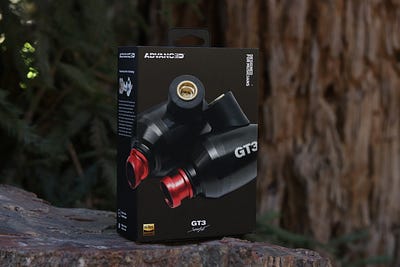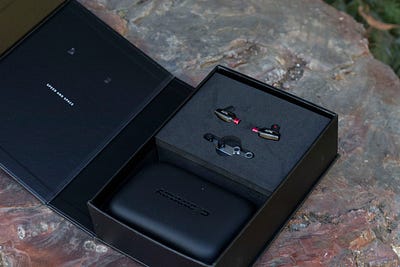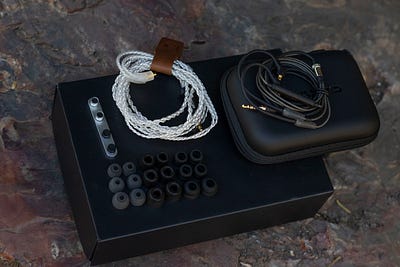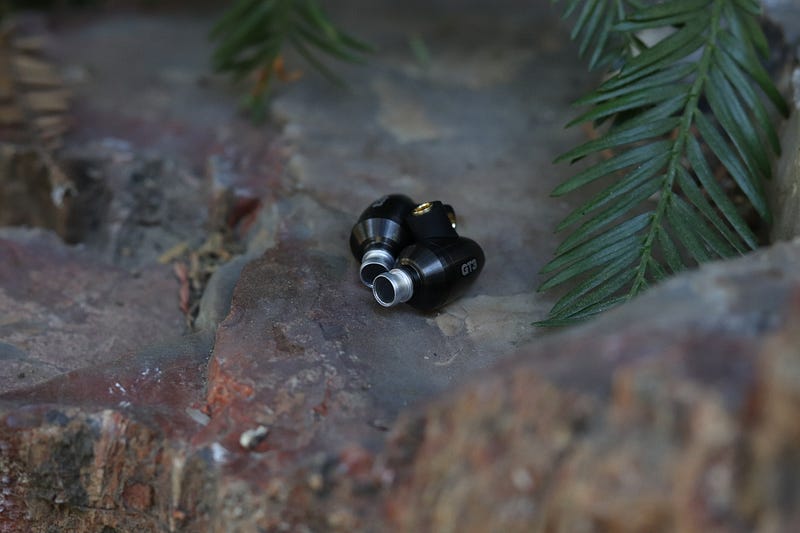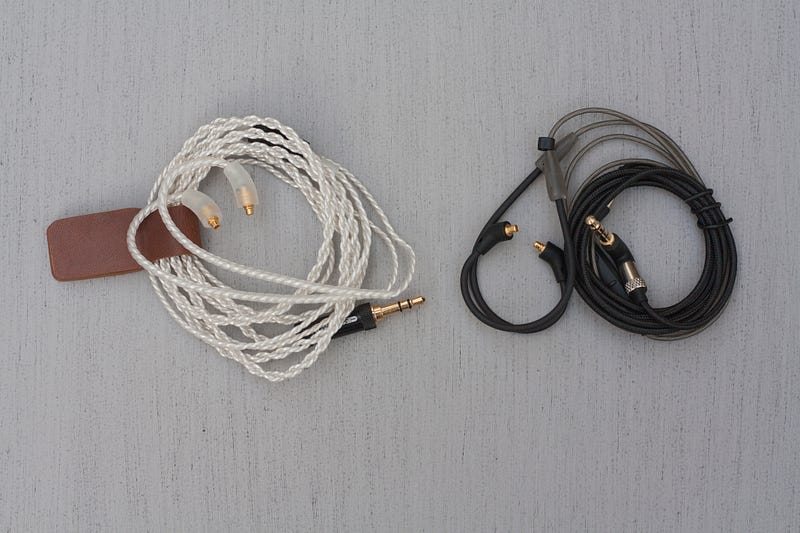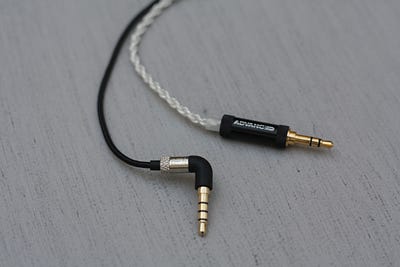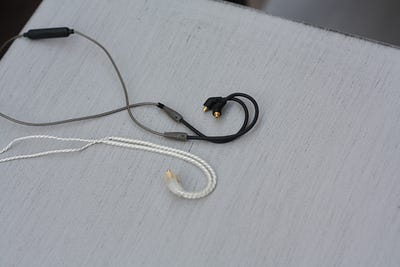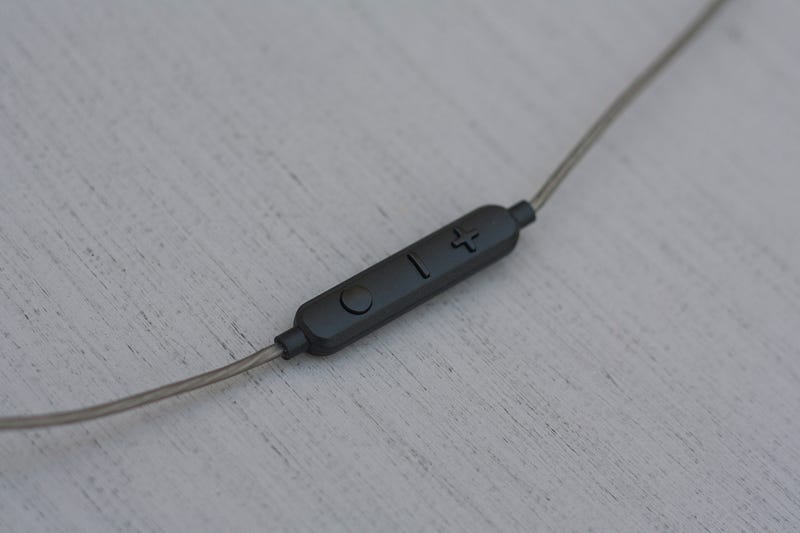Greetings!
Earlier this year ADVANCED released the GT3, an earphone with a super speedy driver, lots of treble, and tons of detail. It's a quality listen and a beautifully built piece of equipment but catered to a more rigid crowd looking for accuracy and clarity than outright fun.
Bass. It is the bane of an audiophiles existence. It doesn't sound natural when it's boosted that much. It's too consumer. It's not as the artist intended. Thank God we've got an EQ to fix it. HA! Get your earplugs ready, because if that's how you feel about bass the earphone we're covering today is your kryptonite. Enter a variant of the ADVANCED GT3. Enter Superbass.
Disclaimer:
A big thanks to Hannah at ADVANCED for arranging a sample of the Superbass for review. The thoughts within this review are my own and do not represent ADVANCED or any other entity. There was no financial incentive provided to write this review.
At the time of this writing, the Superbass was retailing for 199.00 USD: https://www.adv-sound.com/products/gt3
Edit (01-mar-2019): Current price is 349.00 USD. Much harder to recommend at this price, though it is still a good earphone. Score and cons updated accordingly.
Since there is so much overlap with the regular GT3 in terms of fit, build, packaging, etc., those sections of my GT3 review will be repurposed and tailored to the Superbass.
Source and Amping:
For at home use the Superbass was powered by a TEAC HA-501 desktop amp with my Asus FX53V laptop sourcing music. For portable use, music was sourced by an F.Audio S1, LG G6, HiFi E.T. MA8, Shanling M1, or Shanling M0. While all of these can drive it to my low listening volumes adequately, the Superbass is a demanding earphone. As such, many of the above were paired with the Walnut F1 or Auglamour GR-1. I find amping makes the Superbass sound tighter and more controlled.
Personal Preferences:
I listen primarily to various EDM sub-genres (liquid drum and bass, breakbeat, drumstep, etc.), hip hop, and classic rock. While I enjoy a variety of signatures in my headphones I generally lean towards slightly warm with elevated treble and sub-bass, an even and natural mid-range response, with reduced mid-bass. The HiFiMan RE800, Brainwavz B400, and thinksound On2 offer varied examples of signatures I enjoy. I generally listen at very low volumes, so keep this in mind when reading my thoughts on how an earphone sounds.
Specifications:
Packaging and Accessories:
If you've been following ADVANCED over the years, you'll be right at home with the Superbass' excellent unboxing experience. From the masterfully designed exterior sheath to the neat presentation inside, it's nothing short of impressive.
The front of the sheath contains a high resolution, glossy and ever so slightly raised close up image of the Superbass' ear pieces. Top left is the ADVANCED logo, top right their slogan “Designed for Musicians”, bottom left the Hi-Res Audio logo, and bottom middle the model designation with Superbass written in cursive. The left side of the sleeve contains a breakdown of the driver construction along with a description of the goals of this driver design;
“The proprietary driver in GT3 Superbass uses 6µm ultra-thin diaphragm that is specially designed to improve the overall vibration stroke and low-frequency performance. Its voice coil is made with high-purity copper wire which increases its moving mass by nearly 30% compared to it's traditional counterparts. Combined together, GT3 superbass ____ unprecedented level of detail and ____ in its sub/mid-bass region – where ____ reigns supreme over many in its class. ”
All the areas where there is a series of underscores can't be read because part of the image of the Superbass from the front cover wraps around the side and covers the text. While that is in my opinion poor packaging design and layout, it's also pretty funny. To me that shows awareness that the majority of people could care less about what's on the packaging, besides the words 'bass' and a bunch of pretty pictures. The right side of the sleeve contains some marketing fluff, some of which is also covered by the front image overlapping.
Flipping to the rear you are provided a lot of information. Top left is a frequency response graph that shows how each of the three tuning filters alters the Superbass' signature. I expect it will be fairly accurate too, given that was the case with the original GT3 when comparing it to third party measurements. Top right is an image of the ear piece and a single filter, in this case the red treble filter. Just below is an explanation of the Hi-Res logo and what it means. Further down they show off the included MMCX cables, one being silver plater copper and the other equipped with an inline mic for mobile use. Finally, you find an expansive list of what is included with the Superbass, as well as the specifications. In all you get quite a bit;
Overall this is a fantastic unboxing experience. The packaging is attractive, the Superbass is easy to unbox, and you get a slew of accessories that are actually useful. Good stuff as always from ADVANCED.
Build, Comfort, and Isolation:
I've yet to come across anything from ADVANCED that feels poorly constructed. Not even the all-plastic S2000. The Superbass certainly isn't an exception. The second you pick them up you know you're holding something that has been built to last.
The CNC machined steel housings are nigh flawless with amazing fit and finish. The seams that join the front and rear halves of the each housing are impossibly tight. The threading for the interchangeable nozzle filters is smooth and precise, letting you easily screw new filters into place without having to worry about the threads binding. Each filter is also equipped with a rubber gasket preventing unwanted vibrations from de-threading them unexpectedly. They stay securely in place. GT3 and ADV are laser printed on each housing so you don't have to worry about paint interacting with the oils from your skin and wearing off over time. On the top of each housing is a dense rubber protrusion containing the MMCX receptacles. These too line up and follow the curvature of the housings perfectly. Other companies could learn a thing or two from ADVANCED when it comes to the construction of their housings. The Superbass is drop dead gorgeous, especially in the black color scheme they chose to differentiate it from the regular GT3. Now, if I were to levy criticism it would at the rear of each housing which is quite sharp. Thankfully, the way the Superbass fits keeps this edge away from your ear so comfort isn't an issue.
The two cables are quite nice as well. Let's start with the silver-plated copper one. The clear sheath feels extremely dense and tough and shows off the shimmering strands of wire within. The braids are tight and uniform with excellent strain relief everywhere, including both entering the exiting the y-split which is not at all common. The chin cinch slides freely but holds position well and does a great job of minimizing the already limited cable noise. The preformed ear guides are long and flexible, extending well past the bottom of the ear making for a very secure fit. The y-split and compact straight jack are all metal, matching the indestructible build of the ear pieces.
The mobile cable is more traditional with a rubber sheath above the y-split and a cloth sheath below. The rubber section is a touch on the thin side, but the material feels fairly dense so there is little worry about durability issues. The y-split and 90 degree angled jack feel excellent as a result of their steel and rubber construction and are well relieved. The knurling is pronounced and grippy with some laser etched branding that won't rub off. The inline mic and remote is really nice too with a layout that seems to be taking hold within the industry; the multifunction button is on the bottom with the volume controls denoted by + and - signs sitting above. This feels more natural than when the volume controls surround the multifunction button, leading to fewer mispresses. Lastly, the preformed ear guides are flexible and comfortable with a significant rubber relief that also seems to act as a weight for some extra stability.
Comfort is better than you'd expect from a fairly large, steel-bodied earphone. The slight angle of the nozzle combined with the weight displacing ear guides leads to something you can wear comfortably for quite a while. Isolation is good too, slightly above average for a single dynamic in my experience. This is especially noticeable with the foam tips installed. I had no issues listening to these at a comfortable volume while walking around the city.
Sound:
Tips: The stock tips provided with the Superbass pair well with the device, with my preference leaning towards the large bi-flange silicone tips. They let the treble shine which opened up the sound a bit and also reduces mid-bass presence. I also really enjoyed the Superbass with Spinfits which upped the bass slightly over the stock bi-flange.
The Superbass has a fairly intimate vocal presence set within the same large, spacious sound stage as the regular GT3. Depth and width are notable, giving your music a satisfying amount of space to play within. Instrument separation is quite good, further enhancing the sense of space. The presentation is quite layered as well, allowing you to easily discern individual instruments with ease.
Bass is the front runner as you would expect from the product name. While I find it fairly quick, the presentation isn't particularly impactful with notes having a pillowy softness to them. There are exceptions, such as on Skindred's “Ease up” where the Superbass captures the chunky low end quite well. Texture is also fairly good, but not as impressive as something like the TFZ King Pro. The Superbass' low end balance is quite pleasing to my ears. The sub-bass focus keeps the midrange clear and unaffected.
The midrange is thick and sweet with a warm and welcoming tone. The unique qualities and emotions of vocalists shine through, regardless of whether you're listening to Rage Against the Machine's Zach de la Rocha or Sarah Barthel of Phantogram fame. Instruments sound accurate with a realistic timbre and have a fairly snappy attack and decay.
The Superbass' treble is dialed down quite a bit and as such pulls up the rear in terms of emphasis. This serves to greatly emphasize the warmth in the signature. Thankfully, unlike the Massdrop x Mee Audio Planamic that I recently reviewed, treble isn't so recessed as to make some high range sounds almost disappear completely. It's still quite audible and extends well, it just doesn't have a commanding presence. This is a great trait for those who are sensitive to treble but don't want to give up on detail and clarity.
Just as with the regular GT3, the Superbass comes with three different filter options. The filters direct their efforts on a focused frequency range between the upper and lower treble, or between 3K and 5K with lesser affect further up the frequency ranges. They don't have a huge effect on the sound, but it is noticeable and I'm glad they were included. Personally, I spent nearly all my time with the red “treble” filters since they gave the Superbass the most energy. They also benefited the Superbass's sound stage and come across slightly more open and spacious than the other two options, especially the black “bass” filters which to my ears darkened the sound a bit too much. The silver “reference” filters make for a wonderful balance. Free of peaks. Smooth. Detailed. That's the filter I pick when I want to sit and relax.
Select Comparisons: Red filters on Superbass, volumes matched using Dayton iMM-6 & Audiotool
ADVANCED GT3 (silver filter): The Superbass and GT3 are more or less identical when it comes to build, comfort, accessories, isolation, etc. When it comes to sound, they sit on opposing sides of the spectrum.
The GT3's treble is greatly accentuated over the Superbass giving it a lighter, leaner, more nimble impression. This gives the GT3's sound stage some more air to it over the Superbass, though not nearly to the extent you might expect. It's sound stage is only slightly larger. The Superbass's mid range has a thicker, softer presentation compared to the GT3 which comes across much more aggressive. The GT3 also shows more sibilance when pressed. Bass on the GT3 is similar in presentation, but much less forward, more sub-bass prominent, and a little more textured. The GT3 is overall more crisp and detailed, but also much more fatiguing. Those who find the GT3 too treble heavy and aggressive will likely enjoy the Superbass more. Those who find the Superbass too bassy or lacking resolution will likely find more pleasure in the standard GT3. Again, they cater to completely different crowds.
Massdrop x Mee Audio Planamic: The Planamic provides an experience very much focused around the low end. Compared to the Superbass, it relies on a 4K bump to give it energy with a sharp roll off afterwards. As a result, compared to the GT3 it loses out on a lot of track detail that would normally be present in the upper ranges. They're there, just very difficult to pick out in some instances. Not a problem with the Superbass. The Superbass' mid-range is a bit leaner and less forward in the upper regions, with similar emphasis in the lower. Both are fairly lush here, though I'll give the Planamic's unique hybrid dynamic/planar driver the edge in detail and clarity. Bass is where both earphones shine, though the experiences are very different. The Superbass has a softer, more mellow feel to it that envelops you in sub-bass and warmth. The Planamic is much more visceral and aggressive. You feel everything.
When it comes to build, few can compete with the GT3 Superbass. It's steel housings look and feel more premium than the Planamic's 3D-printed setup. The Planamic's low profile housings are more comfortable, though they can only be worn cable up while the Superbass can be worn cable down if you swap out to a cable free of preformed ear guides. Both earphones have amazing cables. The Superbass' silver-plated cable is the best of the four, though both of the Planamic's cables feel more durable and premium than the Superbass' mobile option. The rest of the accessory kits for each earphones are excellent, providing lots of wearing options.
If you're simply looking for the best bass experience the Planamic can't be beat, though you have to be willing to live with the sacrifices it makes in the treble. The Superbass on the other hand has a more well-rounded sound that doesn't sacrifice anything while continuing to provide a high quality low end, along with better build quality. It's a case of a one-trick pony vs. a trained show horse.
Final Thoughts:
The Superbass is a great variant of an earphone that was already outstanding. It takes the signature of the original GT3 then turns it on it's head to avoid redundancy in their lineup. The Superbass caters beautifully to a crowd wanting a bassy earphone that tiptoes into a more premium segment, yet still without costing an arm and a leg.
In addition to the excellent sonic performance (pending it falls in line with your personal preferences) the Superbass is immaculately built and more comfortable than the solid steel housings would suggest. The included cables are nicely made and should last a long time. That said, should they break the Superbass uses standard MMCX connectors so they can be easily replaced. The rest of the accessory kit is comprehensive too, giving you a slew of varied tips to help ensure you can find a good fit. You also get a nice case to store everything in.
If you're in the market for a new earphone and like your bass abundant, give the Superbass an audition.
Thanks for reading!
- B9Scrambler
Some Test Tunes:
Aesop Rock – The Impossible Kid (Album)
Hail Mary Mallon – Are You Going to Eat That? (Album)
King Crimson – Lark’s Tongues in Aspic (Album)
King Crimson – Starless and Bible Black (Track)
Supertramp – Crime of the Century (Album)
Infected Mushroom – Legend of the Black Shawarma (Album)
Gorillaz – Plastic Beach (Album)
Massive Attack – Mezzanine (Album)
Fleetwood Mac – Rumors (Album)
Run the Jewels – Run the Jewels (Album)
The Prodigy – The Day is My Enemy (Album)
Tobacco – screw*d Up Friends (Album)
Felt – Felt 2 (A Tribute to Lisa Bonet) (Album)
Michael Jackson – Thriller (Album)
The Crystal Method – Grace (feat. LeAnn Rimes) (Track)
Jidenna – Long Live the Chief (Track)
Skrillex – Ragga Bomb (Track)
Big Grams – Run for Your Life (Track)
Funkadelic – Maggot Brain (Track)
Aesop Rock – Fishtales (Track)
Earlier this year ADVANCED released the GT3, an earphone with a super speedy driver, lots of treble, and tons of detail. It's a quality listen and a beautifully built piece of equipment but catered to a more rigid crowd looking for accuracy and clarity than outright fun.
Bass. It is the bane of an audiophiles existence. It doesn't sound natural when it's boosted that much. It's too consumer. It's not as the artist intended. Thank God we've got an EQ to fix it. HA! Get your earplugs ready, because if that's how you feel about bass the earphone we're covering today is your kryptonite. Enter a variant of the ADVANCED GT3. Enter Superbass.
Disclaimer:
A big thanks to Hannah at ADVANCED for arranging a sample of the Superbass for review. The thoughts within this review are my own and do not represent ADVANCED or any other entity. There was no financial incentive provided to write this review.
At the time of this writing, the Superbass was retailing for 199.00 USD: https://www.adv-sound.com/products/gt3
Edit (01-mar-2019): Current price is 349.00 USD. Much harder to recommend at this price, though it is still a good earphone. Score and cons updated accordingly.
Since there is so much overlap with the regular GT3 in terms of fit, build, packaging, etc., those sections of my GT3 review will be repurposed and tailored to the Superbass.
Source and Amping:
For at home use the Superbass was powered by a TEAC HA-501 desktop amp with my Asus FX53V laptop sourcing music. For portable use, music was sourced by an F.Audio S1, LG G6, HiFi E.T. MA8, Shanling M1, or Shanling M0. While all of these can drive it to my low listening volumes adequately, the Superbass is a demanding earphone. As such, many of the above were paired with the Walnut F1 or Auglamour GR-1. I find amping makes the Superbass sound tighter and more controlled.
Personal Preferences:
I listen primarily to various EDM sub-genres (liquid drum and bass, breakbeat, drumstep, etc.), hip hop, and classic rock. While I enjoy a variety of signatures in my headphones I generally lean towards slightly warm with elevated treble and sub-bass, an even and natural mid-range response, with reduced mid-bass. The HiFiMan RE800, Brainwavz B400, and thinksound On2 offer varied examples of signatures I enjoy. I generally listen at very low volumes, so keep this in mind when reading my thoughts on how an earphone sounds.
Specifications:
- Driver: Ultra-thin diaphragm (6µm) mass-coil dynamic driver
- Impedance: 84ohms+/- 15%
- Frequency Response: 10Hz – 40,000Hz
- Sensitivity: 95dB+/-3dB at 1kHz
- Rated Power: 1mW
- Input Power: 5mW
- Cable Length: 1.5m (SPC) / 1.2m (mobile)
Packaging and Accessories:
If you've been following ADVANCED over the years, you'll be right at home with the Superbass' excellent unboxing experience. From the masterfully designed exterior sheath to the neat presentation inside, it's nothing short of impressive.
The front of the sheath contains a high resolution, glossy and ever so slightly raised close up image of the Superbass' ear pieces. Top left is the ADVANCED logo, top right their slogan “Designed for Musicians”, bottom left the Hi-Res Audio logo, and bottom middle the model designation with Superbass written in cursive. The left side of the sleeve contains a breakdown of the driver construction along with a description of the goals of this driver design;
“The proprietary driver in GT3 Superbass uses 6µm ultra-thin diaphragm that is specially designed to improve the overall vibration stroke and low-frequency performance. Its voice coil is made with high-purity copper wire which increases its moving mass by nearly 30% compared to it's traditional counterparts. Combined together, GT3 superbass ____ unprecedented level of detail and ____ in its sub/mid-bass region – where ____ reigns supreme over many in its class. ”
All the areas where there is a series of underscores can't be read because part of the image of the Superbass from the front cover wraps around the side and covers the text. While that is in my opinion poor packaging design and layout, it's also pretty funny. To me that shows awareness that the majority of people could care less about what's on the packaging, besides the words 'bass' and a bunch of pretty pictures. The right side of the sleeve contains some marketing fluff, some of which is also covered by the front image overlapping.
Flipping to the rear you are provided a lot of information. Top left is a frequency response graph that shows how each of the three tuning filters alters the Superbass' signature. I expect it will be fairly accurate too, given that was the case with the original GT3 when comparing it to third party measurements. Top right is an image of the ear piece and a single filter, in this case the red treble filter. Just below is an explanation of the Hi-Res logo and what it means. Further down they show off the included MMCX cables, one being silver plater copper and the other equipped with an inline mic for mobile use. Finally, you find an expansive list of what is included with the Superbass, as well as the specifications. In all you get quite a bit;
- GT3 Superbass earphones
- Silver-plated copper cable
- 3-button remote/mic cable
- 3 pairs of foam tips
- 3 pairs of single flange silicone tips
- 3 pairs of dual-flange silicone tips
- Clam-shell carrying case
- Magnetically clasped leather cable tie
Overall this is a fantastic unboxing experience. The packaging is attractive, the Superbass is easy to unbox, and you get a slew of accessories that are actually useful. Good stuff as always from ADVANCED.
Build, Comfort, and Isolation:
I've yet to come across anything from ADVANCED that feels poorly constructed. Not even the all-plastic S2000. The Superbass certainly isn't an exception. The second you pick them up you know you're holding something that has been built to last.
The CNC machined steel housings are nigh flawless with amazing fit and finish. The seams that join the front and rear halves of the each housing are impossibly tight. The threading for the interchangeable nozzle filters is smooth and precise, letting you easily screw new filters into place without having to worry about the threads binding. Each filter is also equipped with a rubber gasket preventing unwanted vibrations from de-threading them unexpectedly. They stay securely in place. GT3 and ADV are laser printed on each housing so you don't have to worry about paint interacting with the oils from your skin and wearing off over time. On the top of each housing is a dense rubber protrusion containing the MMCX receptacles. These too line up and follow the curvature of the housings perfectly. Other companies could learn a thing or two from ADVANCED when it comes to the construction of their housings. The Superbass is drop dead gorgeous, especially in the black color scheme they chose to differentiate it from the regular GT3. Now, if I were to levy criticism it would at the rear of each housing which is quite sharp. Thankfully, the way the Superbass fits keeps this edge away from your ear so comfort isn't an issue.
The two cables are quite nice as well. Let's start with the silver-plated copper one. The clear sheath feels extremely dense and tough and shows off the shimmering strands of wire within. The braids are tight and uniform with excellent strain relief everywhere, including both entering the exiting the y-split which is not at all common. The chin cinch slides freely but holds position well and does a great job of minimizing the already limited cable noise. The preformed ear guides are long and flexible, extending well past the bottom of the ear making for a very secure fit. The y-split and compact straight jack are all metal, matching the indestructible build of the ear pieces.
The mobile cable is more traditional with a rubber sheath above the y-split and a cloth sheath below. The rubber section is a touch on the thin side, but the material feels fairly dense so there is little worry about durability issues. The y-split and 90 degree angled jack feel excellent as a result of their steel and rubber construction and are well relieved. The knurling is pronounced and grippy with some laser etched branding that won't rub off. The inline mic and remote is really nice too with a layout that seems to be taking hold within the industry; the multifunction button is on the bottom with the volume controls denoted by + and - signs sitting above. This feels more natural than when the volume controls surround the multifunction button, leading to fewer mispresses. Lastly, the preformed ear guides are flexible and comfortable with a significant rubber relief that also seems to act as a weight for some extra stability.
Comfort is better than you'd expect from a fairly large, steel-bodied earphone. The slight angle of the nozzle combined with the weight displacing ear guides leads to something you can wear comfortably for quite a while. Isolation is good too, slightly above average for a single dynamic in my experience. This is especially noticeable with the foam tips installed. I had no issues listening to these at a comfortable volume while walking around the city.
Sound:
Tips: The stock tips provided with the Superbass pair well with the device, with my preference leaning towards the large bi-flange silicone tips. They let the treble shine which opened up the sound a bit and also reduces mid-bass presence. I also really enjoyed the Superbass with Spinfits which upped the bass slightly over the stock bi-flange.
The Superbass has a fairly intimate vocal presence set within the same large, spacious sound stage as the regular GT3. Depth and width are notable, giving your music a satisfying amount of space to play within. Instrument separation is quite good, further enhancing the sense of space. The presentation is quite layered as well, allowing you to easily discern individual instruments with ease.
Bass is the front runner as you would expect from the product name. While I find it fairly quick, the presentation isn't particularly impactful with notes having a pillowy softness to them. There are exceptions, such as on Skindred's “Ease up” where the Superbass captures the chunky low end quite well. Texture is also fairly good, but not as impressive as something like the TFZ King Pro. The Superbass' low end balance is quite pleasing to my ears. The sub-bass focus keeps the midrange clear and unaffected.
The midrange is thick and sweet with a warm and welcoming tone. The unique qualities and emotions of vocalists shine through, regardless of whether you're listening to Rage Against the Machine's Zach de la Rocha or Sarah Barthel of Phantogram fame. Instruments sound accurate with a realistic timbre and have a fairly snappy attack and decay.
The Superbass' treble is dialed down quite a bit and as such pulls up the rear in terms of emphasis. This serves to greatly emphasize the warmth in the signature. Thankfully, unlike the Massdrop x Mee Audio Planamic that I recently reviewed, treble isn't so recessed as to make some high range sounds almost disappear completely. It's still quite audible and extends well, it just doesn't have a commanding presence. This is a great trait for those who are sensitive to treble but don't want to give up on detail and clarity.
Just as with the regular GT3, the Superbass comes with three different filter options. The filters direct their efforts on a focused frequency range between the upper and lower treble, or between 3K and 5K with lesser affect further up the frequency ranges. They don't have a huge effect on the sound, but it is noticeable and I'm glad they were included. Personally, I spent nearly all my time with the red “treble” filters since they gave the Superbass the most energy. They also benefited the Superbass's sound stage and come across slightly more open and spacious than the other two options, especially the black “bass” filters which to my ears darkened the sound a bit too much. The silver “reference” filters make for a wonderful balance. Free of peaks. Smooth. Detailed. That's the filter I pick when I want to sit and relax.
Select Comparisons: Red filters on Superbass, volumes matched using Dayton iMM-6 & Audiotool
ADVANCED GT3 (silver filter): The Superbass and GT3 are more or less identical when it comes to build, comfort, accessories, isolation, etc. When it comes to sound, they sit on opposing sides of the spectrum.
The GT3's treble is greatly accentuated over the Superbass giving it a lighter, leaner, more nimble impression. This gives the GT3's sound stage some more air to it over the Superbass, though not nearly to the extent you might expect. It's sound stage is only slightly larger. The Superbass's mid range has a thicker, softer presentation compared to the GT3 which comes across much more aggressive. The GT3 also shows more sibilance when pressed. Bass on the GT3 is similar in presentation, but much less forward, more sub-bass prominent, and a little more textured. The GT3 is overall more crisp and detailed, but also much more fatiguing. Those who find the GT3 too treble heavy and aggressive will likely enjoy the Superbass more. Those who find the Superbass too bassy or lacking resolution will likely find more pleasure in the standard GT3. Again, they cater to completely different crowds.
Massdrop x Mee Audio Planamic: The Planamic provides an experience very much focused around the low end. Compared to the Superbass, it relies on a 4K bump to give it energy with a sharp roll off afterwards. As a result, compared to the GT3 it loses out on a lot of track detail that would normally be present in the upper ranges. They're there, just very difficult to pick out in some instances. Not a problem with the Superbass. The Superbass' mid-range is a bit leaner and less forward in the upper regions, with similar emphasis in the lower. Both are fairly lush here, though I'll give the Planamic's unique hybrid dynamic/planar driver the edge in detail and clarity. Bass is where both earphones shine, though the experiences are very different. The Superbass has a softer, more mellow feel to it that envelops you in sub-bass and warmth. The Planamic is much more visceral and aggressive. You feel everything.
When it comes to build, few can compete with the GT3 Superbass. It's steel housings look and feel more premium than the Planamic's 3D-printed setup. The Planamic's low profile housings are more comfortable, though they can only be worn cable up while the Superbass can be worn cable down if you swap out to a cable free of preformed ear guides. Both earphones have amazing cables. The Superbass' silver-plated cable is the best of the four, though both of the Planamic's cables feel more durable and premium than the Superbass' mobile option. The rest of the accessory kits for each earphones are excellent, providing lots of wearing options.
If you're simply looking for the best bass experience the Planamic can't be beat, though you have to be willing to live with the sacrifices it makes in the treble. The Superbass on the other hand has a more well-rounded sound that doesn't sacrifice anything while continuing to provide a high quality low end, along with better build quality. It's a case of a one-trick pony vs. a trained show horse.
Final Thoughts:
The Superbass is a great variant of an earphone that was already outstanding. It takes the signature of the original GT3 then turns it on it's head to avoid redundancy in their lineup. The Superbass caters beautifully to a crowd wanting a bassy earphone that tiptoes into a more premium segment, yet still without costing an arm and a leg.
In addition to the excellent sonic performance (pending it falls in line with your personal preferences) the Superbass is immaculately built and more comfortable than the solid steel housings would suggest. The included cables are nicely made and should last a long time. That said, should they break the Superbass uses standard MMCX connectors so they can be easily replaced. The rest of the accessory kit is comprehensive too, giving you a slew of varied tips to help ensure you can find a good fit. You also get a nice case to store everything in.
If you're in the market for a new earphone and like your bass abundant, give the Superbass an audition.
Thanks for reading!
- B9Scrambler
***** ***** ***** ***** *****
Some Test Tunes:
Aesop Rock – The Impossible Kid (Album)
Hail Mary Mallon – Are You Going to Eat That? (Album)
King Crimson – Lark’s Tongues in Aspic (Album)
King Crimson – Starless and Bible Black (Track)
Supertramp – Crime of the Century (Album)
Infected Mushroom – Legend of the Black Shawarma (Album)
Gorillaz – Plastic Beach (Album)
Massive Attack – Mezzanine (Album)
Fleetwood Mac – Rumors (Album)
Run the Jewels – Run the Jewels (Album)
The Prodigy – The Day is My Enemy (Album)
Tobacco – screw*d Up Friends (Album)
Felt – Felt 2 (A Tribute to Lisa Bonet) (Album)
Michael Jackson – Thriller (Album)
The Crystal Method – Grace (feat. LeAnn Rimes) (Track)
Jidenna – Long Live the Chief (Track)
Skrillex – Ragga Bomb (Track)
Big Grams – Run for Your Life (Track)
Funkadelic – Maggot Brain (Track)
Aesop Rock – Fishtales (Track)












